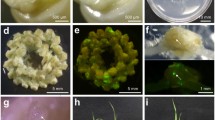Abstract
The parameters for delivery of expression cassettes to cells of wheat morphogenic callus induced from immature embryos were optimized. Three systems (gradation, delayed, and regeneration) for in vitro selection of transgenic wheat tissue using the bar gene, providing resistance to the herbicide phosphinothricin (PPT), were compared. The efficiency of gene delivery to the cells competent for plant regeneration was assessed by comparing the number of spots transiently expressing uidA gene (encoding β-glucuronidase) per unit surface of the morphogenic calluses treated under various conditions. The selection systems in question were evaluated by comparing the transformation efficiency frequencies. The optimal parameters for wheat biolistic transformation using a particle inflow gun were determined, namely, the distance between the particle source and the target tissue (12 cm) and helium pressure during the shot (6 atm). The optimal time of callus tissue development on the medium inducing callus formation was determined (10–14 days). Comparison of the three selection variants demonstrated that the regeneration system was the most efficient for producing true transgenic plants of common wheat.
Similar content being viewed by others
References
Sanford, J.C., Klein, T.M., Wolf, E.D., and Allen, N., Delivery of Substances into Cells and Tissues Using a Particle Bombardment Process, J. Particulate Sci. Technol., 1987, no. 5, pp. 27–37.
Finer, J.J., Vain, P., Jones, M.W., and McMullen, M.D., Development of the Particle Inflow Gun for DNA Delivery to the Plant Cells, Plant Cell Rep., 1992, no. 11, pp. 323–328.
Takeuchi, Y., Dotson, M., and Keen, N.T., Plant Transformation: A Simple Particle Bombardment Device Based on Flowing Helium, Plant. Mol. Biol., 1992, vol. 18, no. 4, pp. 835–839.
Sautter, C., Waldner, H., Neuhaus-Url, G., et al., Micro-Targeting: High Efficiency Gene Transfer Using a Novel Approach for the Acceleration of Microprojectiles, Bio/Technology, 1991, no. 9, pp. 1080–1085.
Christou, P., McCabe, D.E., and Swain, W.F., Stable Transformation of Soybean Callus by DNA-Coated Gold Particles, Plant Physiol., 1988, no. 87, pp. 671–674.
Gaponenko, A.K., Muntyan, M.A., Malikova, N.I., and Sozinov, A.A., In Vitro Regeneration of Wheat Triticum aestivum L. Plants of Various Genotypes, Dokl. Akad. Nauk SSSR, 1984, vol. 278, no. 5, pp. 1231–1235.
Chalfie, M., Tu, Y., Euskirchen, G., et al., Green Fluorescent Protein As a Marker for Gene Expression, Science, 1994, no. 263, pp. 802–805.
Richards, H.A., Rudas, V.A., Sun, H., et al., Construction of a GFP-BAR Plasmid and Its Use for Switch Grass Transformation, Plant Cell Rep., 2001, no. 20, pp. 48–54.
Jefferson, R.A., Assaying Chimeric Genes in Plants: The gus Gene Fusion System, Plant Mol. Biol., 1987, rep. 5, pp. 387–405.
Hess, D., Dressler, K., and Nimmrichter, R., Transformation Experiments by Pipetting Agrobacterium into the Spikelets of Wheat (Triticum aestivum L.), Plant Sci., 1990, no. 72, pp. 233–244.
Rasco-Gaunt, S., Riley, A., Barcelo, P., and Lazzeri, P.A., Analysis of Particle Bombardment Parameters to Optimized DNA Delivery into Wheat Tissues, Plant Cell Rep., 1999, no. 19, pp. 118–127.
Gaponenko, A.K., RF Patent no. 2193066 (2002).
Zhang, P. and Puonti-Kaerlas, J., PIG-Mediated Cassava Transformation Using Positive and Negative Selection, Plant Cell Rep., 2000, no. 19, pp. 939–945.
Schenk, P.M., Elliott, A.R., and Manners, J.M., Assessment of Transient Gene Expression in Plant Tissues Using the Green Fluorescent Protein, Ref. Plant Mol. Biol., 1998, rep. 16, pp. 313–322.
Chen, W.P., Gu, X., Liang, G.H., et al., Introduction and Constitutive Expression of a Rice Chitinase Gene in Bread Wheat Using Ballistic Bombardment and the bar Gene As a Selectable Marker, Theor. Appl. Genet., 1998, vol. 97, pp. 1296–1306.
Wild, A., Sauer, H., and Ruhle, W., The Effect of Phosphinothricin (Glufosinate) on Photosynthesis I Inhibition of Photosynthesis and Accumulation of Ammonia, Z. Naturforsch., A: Phys. Sci., 1987, vol. 42, pp. 263–269.
Vasil, V., Castilo, A.M., Fromm, M.E., and Vasil, I.K., Herbicide Resistant Fertile Transgenic Wheat Plants Obtained by Microprojectile Bombardment of Regenerable Embryogenic Callus, Biotechnology, 1992, vol. 10, pp. 667–673.
Uze, M., Potrykus, I., and Sautter, C., Single-Stranded DNA in the Genetic Transformation of Wheat (Triticum aestivum L.): Transformation Frequency and Integration Pattern, Theor. Appl. Genet., 1999, vol. 99, pp. 487–495.
Wild, A. and Manderscheid, R., The Effect of Phosphinothricin on the Assimilation of Ammonia in Plants, Z. Naturforsch., A: Phys. Sci., 1984, vol. 39, pp. 500–504.
Weeks, J.T., Anderson, O.D., and Blechl, A.E., Rapid Production of Multiple Independent Lines of Fertile Transgenic Wheat (Triticum aestivum L.), Plant Physiol., 1993, vol. 102, pp. 1077–1084.
Altpeter, F., Vasil, V., Srivastava, V., et al., Accelerated Production of Transgenic Wheat (Triticum aestivum L.) Plants, Plant Cell Rep., 1996, vol. 16, pp. 12–17.
Becker, D., Brettschneider, R., and Lörz, H., Fertile Transgenic Wheat from Microprojectile Bombardment of Scutellar Tissue, Plant J., 1994, vol. 5, pp. 299–307.
Wright, M., Dawson, J., Dunder, E., et al., Efficient Ballistic Transformation of Maize (Zea mays L.) and Wheat (Triticum aestivum L.) Using the Phosphomannose Isomerase Gene, pmi, As the Selectable Marker, Plant Cell Rep., 2001, vol. 20, pp. 429–436.
Huber, M., Hahn, R., and Hess, D., High Transformation Frequencies Obtained from a Commercial Wheat (Triticum aestivum L. cv. “Combi”) by Microbombardment of Immature Embryos Followed by GFP Screening Combined with PPT Selection, Mol. Breeding, 2002, vol. 10, pp. 19–30.
Jakson, S.A., Zhang, P., Chen, W.P., et al., High-Resolution Structural Analysis of Ballistic Transgene Integration into Genome of Wheat, Theor. Appl. Genet., 2001, vol. 103, pp. 56–62.
Author information
Authors and Affiliations
Additional information
Original Russian Text © V.S. Fadeev, O.V. Blinkova, A.K. Gaponenko, 2006, published in Genetika, 2006, Vol. 42, No. 4, pp. 507–518.
Rights and permissions
About this article
Cite this article
Fadeev, V.S., Blinkova, O.V. & Gaponenko, A.K. Optimization of biological and physical parameters for biolistic genetic transformation of common wheat (Triticum aestivum L.) using a particle inflow gun. Russ J Genet 42, 402–411 (2006). https://doi.org/10.1134/S1022795406040077
Received:
Issue Date:
DOI: https://doi.org/10.1134/S1022795406040077




